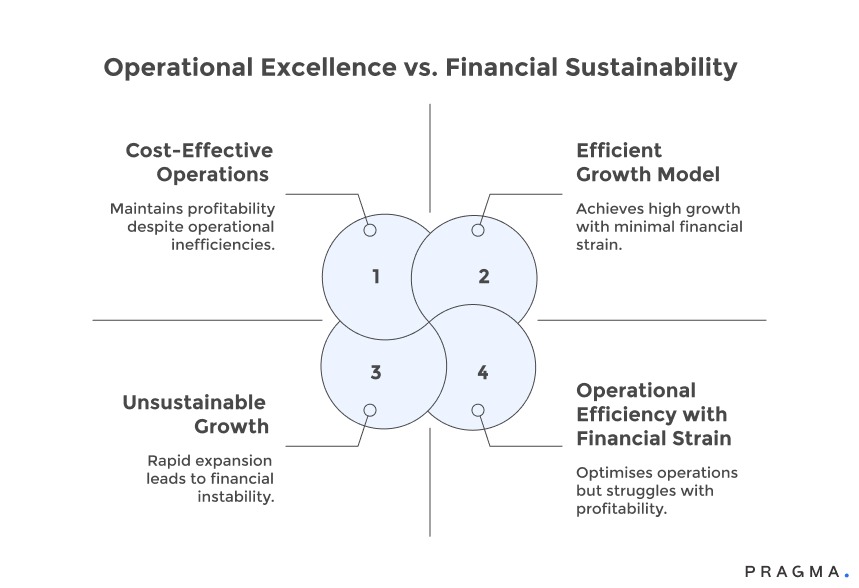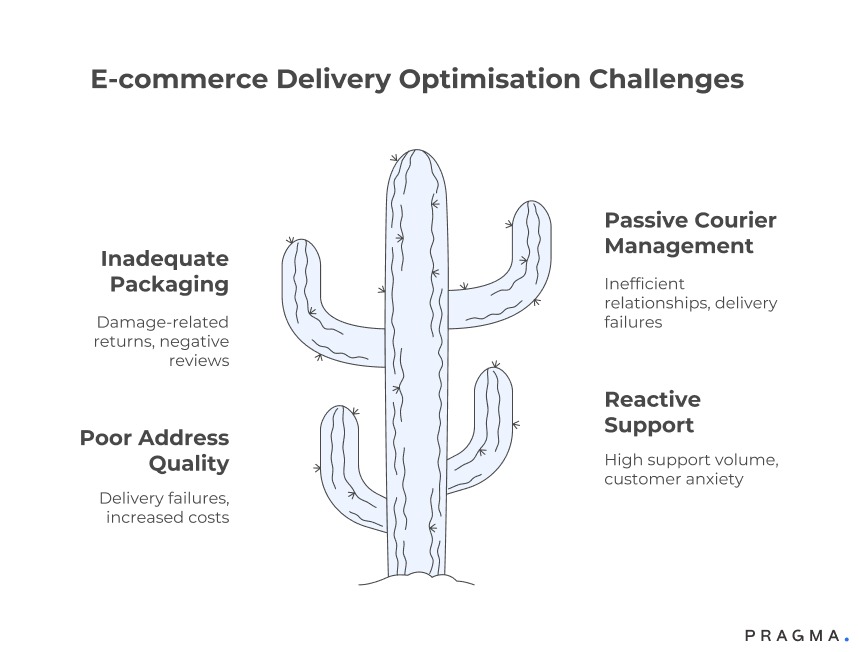The Indian D2C landscape has witnessed phenomenal growth over the past decade, driven by digital penetration, evolving consumer preferences, and innovative branding. Yet, as competition intensifies, product innovation alone is no longer enough to win and retain customers profitably. The next wave of growth for Indian D2C brands hinges on operational excellence—where smarter, data-driven, and automated processes become the true differentiators.
From optimised supply chain management and predictive logistics to automation-led customer engagement and real-time analytics dashboards, operational intelligence empowers brands to scale efficiently, reduce costs, and elevate customer experiences. In a market as diverse and complex as India—spanning metros to Tier-3 towns—these smarter operations will enable brands not only to meet consumer expectations but to anticipate and exceed them.
This blog explores How the Next Wave of Indian D2C Growth Will Be Driven by Smarter Operations and how Indian D2C brands can leverage technology, AI, and process innovation to power the next chapter of growth. We’ll dive into real-world examples and strategic frameworks that show why operational maturity is the key to sustainable success in today’s hyper-competitive e-commerce ecosystem.
Why has operational excellence become the primary competitive differentiator?
Market maturation and funding discipline shift competitive advantage from acquisition scale to execution quality
Customer acquisition cost inflation has rendered growth-at-any-cost models economically unviable. CAC across Indian D2C categories increased 140-180% between 2020-2024 as digital advertising maturity, platform algorithm changes, and competition intensification drove up acquisition costs.
Brands acquiring customers at ₹680 with ₹1,200 first-order values require 2.8+ repeat purchases achieving profitability—retention rates that operationally-excellent brands achieve but mediocre executors never reach. The rising CAC makes operational efficiency difference between profitable scaling and perpetual subsidy.
Funding environment transformation from growth-obsessed to profitability-demanding changes investor expectations fundamentally. Post-2022 funding winter, investors scrutinise unit economics, burn rates, and paths to profitability with intensity absent during growth-obsessed years. Brands demonstrating operational competence through positive contribution margins, manageable RTO rates, and efficient fulfilment attract capital at reasonable valuations whilst operationally-challenged brands face down-rounds or funding unavailability. The capital access advantage flowing to operational leaders creates compounding gap as excellent operators invest in further improvements whilst struggling peers lack resources for necessary operational investments.
Competitive intensity in established categories eliminates differentiation based purely on product or positioning. When 15 brands sell similar kurtas, 20 offer comparable skincare, and 12 provide equivalent electronics, product differentiation provides minimal advantage.
- Operational excellence
- faster delivery
- reliable quality
- easy returns
- responsive service
becomes the primary competitive moat. Customers choosing between similar products at similar prices select brands delivering superior experiences through operational competence. The execution quality difference determines market share when product parity exists.
Market maturity brings customer sophistication expecting operational excellence as baseline. Early D2C adopters tolerated 8-day deliveries, 30% RTO rates, and slow customer service as novel online shopping trade-offs.
Today's mainstream customers expect Amazon-level reliability from all e-commerce—3-4 day delivery, <10% RTO rates, responsive support. Brands unable to match these operational standards lose customers to competitors who can, regardless of marketing spend or brand positioning. The operational table stakes keep rising as customer expectations compound.

What operational capabilities separate winners from strugglers?
Specific execution competencies create measurable advantages translating to superior unit economics
Delivery reliability consistently meeting customer promises builds trust that marketing cannot replicate. Brands delivering 94-96% of orders within committed timeframes generate 34-41% higher repeat purchase rates than those achieving 78-84% on-time delivery.
The reliability difference compounds over customer lifecycle—reliable brands retain customers who become advocates generating referrals, whilst unreliable brands constantly replace churning customers through expensive acquisition. The delivery excellence investment pays returns far exceeding costs through retention and organic growth.
RTO rate management below 20% creates unit economic advantages that struggling brands cannot overcome. Every percentage point RTO improvement saves ₹12-18 per order through avoided logistics costs, recovered inventory, and reduced operational overhead. Brands at 16% RTO enjoy ₹144-216 per-order advantage versus those at 28% RTO.
At 5,000 monthly orders, this compounds to ₹7.2-10.8 lakhs monthly or ₹86.4 lakhs-₹1.3 crores annually—often the difference between profitability and loss. The RTO discipline creates self-reinforcing advantage as saved costs fund further operational improvements.
First-attempt delivery success above 70% accelerates cash conversion whilst reducing costs. Brands achieving 75-82% first-attempt success deliver products 2-3 days faster than those at 58-65%, compressing cash conversion cycles from 9-12 days to 6-8 days.
The faster cash conversion reduces working capital requirements by 25-35%, enabling inventory investments, marketing spend, or profitability without additional funding. The operational efficiency literally creates financial capacity that operationally-challenged brands lack.
Customer service efficiency resolving 65%+ queries in first contact reduces support costs whilst improving satisfaction. Brands achieving 70-75% first-contact resolution handle support at ₹18-28 per order versus ₹45-68 for those at 45-55% resolution requiring multiple interactions.
The efficiency advantage scales—at 10,000 monthly orders, the difference amounts to ₹2.7-4.8 lakhs monthly support cost savings. The resources saved fund growth initiatives whilst superior service quality drives retention and referrals generating organic growth.

How does operational data visibility enable competitive advantage?
Measurement infrastructure revealing operational reality enables optimisation that data-blind competitors cannot achieve
Granular performance visibility across operational dimensions identifies specific improvement opportunities hidden in aggregate metrics. Brands tracking RTO rates by pin code, carrier, product category, customer segment, and order value identify precise problem areas rather than treating RTO as a monolithic challenge.
Discovering that specific pin codes show 42% RTO whilst others maintain 12%, or that particular product categories drive elevated returns, enables targeted interventions delivering outsized improvements. Data-blind competitors applying universal solutions achieve marginal gains whilst data-driven brands surgically address root causes.
Real-time operational dashboards surfacing issues within hours enable rapid correction preventing problem accumulation. Brands detecting delivery promise breaches within 24 hours can proactively communicate delays, escalate with couriers, or expedite alternatives. Those discovering problems days later through delayed reporting cannot prevent customer dissatisfaction already occurring. The temporal advantage in problem detection creates an experience quality gap that aggregates across thousands of customer interactions into significant satisfaction and retention differences.
Cohort analysis revealing customer segment performance differences enables resource allocation optimisation.
Tracking acquisition channel performance not just by initial conversion but by 180-day retention, LTV, and RTO rates identifies which sources generate genuinely valuable customers versus high-maintenance deal-seekers.
Reallocating marketing spend toward channels producing customers with 65% repeat rates and 15% RTO away from those generating 28% repeat rates and 38% RTO improves overall customer base quality whilst reducing acquisition costs. Data-driven allocation produces progressively better unit economics whilst uniform allocation across channels maintains mixed results.
Predictive analytics anticipating operational issues enable proactive intervention preventing problems. Models predicting which orders carry elevated RTO risk enable verification workflows preventing delivery failures.
Inventory forecasting predicting stockouts 7-10 days early enables emergency sourcing preventing lost sales. Delivery timing predictions identifying likely delays enable proactive customer communication managing expectations. The anticipatory capability transforms operations from reactive firefighting to proactive problem prevention, creating customer experience quality that reactive competitors cannot match regardless of resources invested in recovery efforts.
What operational improvements deliver disproportionate returns?
Strategic intervention prioritisation identifies high-leverage changes producing outsized impact relative to effort

Here's how brands can achieve this:
1. Enhance Address Quality at Checkout:
- Problem: 40-50% of delivery failures stem from poor address quality.
- Solution: Invest in address validation, landmark prompting, and geocoding verification.
- Cost vs. Savings: ₹3-8 per order investment prevents ₹220-280 in delivery failure costs, yielding a 28-35x ROI.
- Current Issue: Many brands focus on downstream recovery (customer service, returns) instead of upstream prevention.
2. Automate Order Status Communication:
- Problem: High support volume due to customer anxiety about order status.
- Solution: Implement comprehensive notification systems sending 5-6 milestone updates from order to delivery.
- Cost vs. Savings: ₹2-4 per order for messaging reduces support tickets from 0.4-0.6 to 0.2-0.3 per order. At ₹180-240 per ticket, this saves ₹36-72 per order.
- Benefit: 9-18x ROI and competitive differentiation through superior transparency.
3. Optimise Packaging to Reduce Damage:
- Problem: Damage-related returns impact customer satisfaction and increase costs.
- Solution: Invest an additional ₹8-15 per order in protective packaging.
- Cost vs. Savings: Prevents ₹240-320 in damage-related returns (occurring at 4-6% of orders), delivering a 4-6x ROI.
- Benefit: Improved unboxing experiences, social sharing, and positive reviews.
- Current Issue: Brands often minimise packaging costs, leading to higher damage complaints.
4. Proactively Manage Courier Performance:
- Problem: Inefficient courier relationships lead to delivery failures.
- Solution: Implement systematic monitoring, monthly reviews, and performance-based allocation through SLA tracking and vendor accountability.
- Benefit: Reduces delivery failures by 20-30% and incentivises courier excellence.
- Current Issue: Many brands treat couriers as passive vendors instead of active performance partners.
Quick Wins
Week 1: Operational Baseline Assessment
Calculate current performance across
key operational dimensions:
- delivery promise accuracy (committed vs actual delivery timing last 500 orders)
- RTO rate overall and by segment (pin code, product category, customer type)
- first-attempt delivery success (successful first deliveries / total attempts)
- support efficiency (first-contact resolution rate, average tickets per order)
- and inventory turnover (annual COGS / average inventory value).
Survey 50-100 customers about operational experience asking specific questions about delivery timing, product quality, and service responsiveness. Benchmark performance against category standards identifying largest gaps versus competitors.
Expected outcome: Quantified operational baseline with specific weaknesses prioritised by impact on customer satisfaction and unit economics.
Week 2: High-Leverage Improvement Identification
Analyse which operational weaknesses create largest economic drag. Calculate potential savings from improvements: RTO reduction from current XX% to 18% saves ₹XX per order, delivery promise improvement from XX% to 94% increases repeat rate by YY% worth ₹ZZ LTV gain, support efficiency from XX% to 70% first-contact resolution saves ₹XX per order. Prioritise top 3-4 improvements by ROI considering implementation difficulty. Design specific intervention plans with clear success metrics and ownership assignments. Create investment cases for each priority showing costs, timeline, and expected returns.
Expected outcome: Prioritised operational improvement roadmap with quantified business cases justifying resource allocation to highest-impact initiatives.
Week 3: Quick-Win Implementation
Execute 2-3 highest-leverage improvements requiring minimal investment:
- implement address validation at checkout preventing delivery failures
- set up automated order status notifications reducing support volume
- create courier performance tracking enabling vendor accountability conversations.
These changes typically require 1-2 weeks implementation with immediate impact on operational metrics. Measure improvement weekly tracking progress toward targets. Communicate changes to customers where relevant building perception of continuous service improvement.
Expected outcome: Initial operational improvements demonstrating measurable impact within 2-3 weeks, building momentum and stakeholder confidence in operational excellence strategy.
Week 4: Operational Dashboard and Measurement
Establish comprehensive operational dashboard tracking all
key metrics with daily refresh:
- delivery performance
- RTO rates by segment
- support efficiency
- inventory turns
contribution margin by customer cohort.
Set up automated alerts flagging performance degradation requiring investigation. Create weekly operational review cadence examining trends, celebrating improvements, and identifying emerging issues. Begin cohort analysis tracking how operational improvements affect customer retention and LTV over time. Share operational metrics with entire team building organisation-wide focus on execution excellence.
Expected outcome: Systematic measurement infrastructure enabling continuous operational improvement through visibility, accountability, and rapid issue detection.
To Wrap It Up
Indian D2C's next growth wave belongs to brands mastering operational fundamentals rather than those simply outspending competitors on acquisition. The market maturation and funding discipline shift competitive advantage from marketing scale to execution quality, creating permanent divergence between operationally-excellent brands achieving profitable growth and operationally-challenged brands trapped in unsustainable burn cycles.
The operational capabilities—delivery reliability, RTO management, customer service excellence, inventory efficiency
create compounding advantages through improved retention, reduced costs, and organic growth that capital-intensive acquisition never produces sustainably.
Calculate your current monthly operational waste—RTO costs, support expenses, delivery failures—then model how eliminating half this waste would change your path to profitability, potentially discovering that operational excellence provides faster route to sustainability than raising next funding round.
Long-term competitive advantage in Indian D2C will separate brands treating operations as strategic differentiator from those viewing it as back-office function. Customer expectations continue rising, acquisition costs keep increasing, and funding discipline persists, making operational excellence progressively more valuable whilst operational mediocrity becomes progressively more expensive.
Brands investing systematically in execution capabilities today build unassailable competitive moats that well-funded but poorly-operated competitors cannot cross regardless of capital advantages. The compound returns of operational excellence create sustainable competitive advantages that marketing spend or product innovation alone never achieve in maturing, competitive markets.
For D2C brands seeking to build operational excellence as competitive advantage, Pragma's unified operations platform provides end-to-end visibility across delivery, returns, customer service, and inventory management that helps brands achieve 67-73% improvement in unit economics whilst reducing capital requirements by 34-41% through operational capabilities enabling profitable scaling rather than capital-intensive growth.

FAQs (Frequently Asked Questions On How the Next Wave of Indian D2C Growth Will Be Driven by Smarter Operations)
1. Can operational improvements really drive growth or just reduce costs?
Superior operations drive growth through three mechanisms: higher retention (satisfied customers buy more), referrals (great experiences generate word-of-mouth), and competitive advantage (reliability attracts customers from inferior competitors). Brands with <18% RTO grow 2.3x faster than those >30% RTO through these compounding effects beyond simple cost savings.
2. How long does operational transformation take before seeing financial impact?
Quick wins appear within 30-60 days (support cost reduction, RTO improvements from verification). Substantial financial impact emerges at 90-180 days as retention improvements flow through LTV calculations. Full transformation to self-funding growth takes 12-18 months but progressive improvements deliver continuous returns throughout journey.
3. What if competitors outspend us on marketing whilst we focus on operations?
Let them. They're acquiring expensive, low-retention customers whilst burning capital. You're building high-retention customer base with positive economics. They'll need perpetual funding; you'll generate cash. In 18-24 months, you'll still be growing whilst they're scrambling for bridge rounds. Operational excellence is long game that wins.
4. Should we hire operations experts or train existing team?
Both. Hire 1-2 senior operational specialists bringing best practices and frameworks. Train existing team implementing improvements—they know your specific context and customers. The combination of external expertise and internal knowledge produces faster transformation than either alone. Budget 60/40 split favouring internal development.
5. How do we convince investors that operations matter more than growth?
Show the math: demonstrate how operational improvements expand contribution margin, reduce CAC through retention, and create self-funding growth. Compare your unit economics trajectory versus growth-obsessed competitors. Forward-thinking investors increasingly recognise operational excellence as primary value driver. Those who don't will learn through portfolio company failures.
Talk to our experts for a customised solution that can maximise your sales funnel
Book a demo




.png)